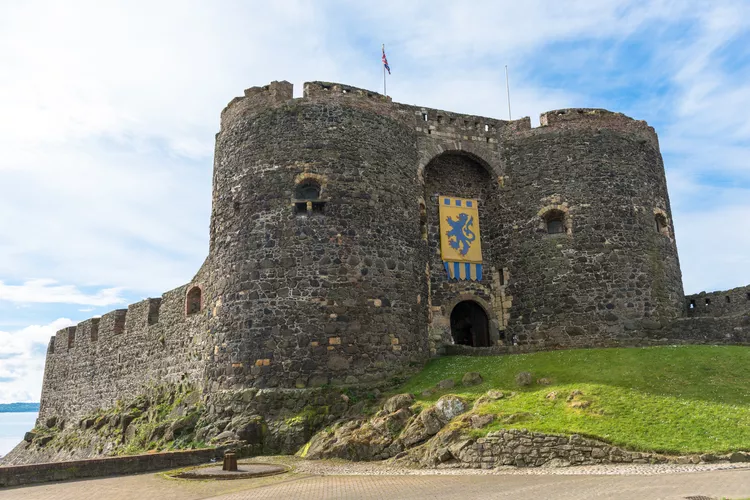Belfast may be the more famous city nearby, but Carrickfergus reveals a rich history that predates the capital. Learn about the iconic Carrickfergus Castle, its strategic significance, and the many experiences waiting for you in this historic town.
History
Carrickfergus is named after the legendary King Fergus, the first King of Scotland. It is said that he sailed from Scotland to Ulster in 501 A.D. in search of a cure for his leprosy. Nevertheless, tragedy struck as his ship struck a dangerous outcropping of basalt rock, known as a “carraig,” leading to his drowning and subsequent burial. Consequently, the rock that sank his vessel was named Carraig-Fergus.
The castle itself is constructed on the very rock connected to King Fergus. The initial fortifications were erected in 1178 by John de Courcy under the reign of King Henry, who aimed to establish Anglo-Norman dominance in Ireland.
This strategic location, surrounded by shallow sea on three sides, led to ongoing construction over the years. By 1242, Carrickfergus Castle stood complete, remarkably preserving its medieval architecture to this day.
Throughout the next 600 years, Carrickfergus Castle served as a crucial defensive stronghold for Ireland. Any invader aspiring to control Ireland had to conquer this fortress. The castle endured attacks from the Scots, French, and English, continuing its military significance well into the 19th and 20th centuries.
By the 1800s, the castle transitioned into a military prison and armory. During World War I, it became a military garrison. After the war, Carrickfergus Castle was designated a protected historical site in 1928 by the Ministry of Finance, although it served as an air raid shelter during World War II. Nowadays, it stands as an iconic landmark complete with an informative visitor’s center.
What to See
Carrickfergus Castle ranks among the best-preserved medieval castles in Ireland, allowing visitors to walk through its storied halls. Within the castle, a visitor’s center features an impressive collection of 17th-19th century cannons. While the exterior can be admired from the waterfront, entering the castle offers an unparalleled opportunity to experience its timeless history.
Location and How to Visit
Carrickfergus Castle is located in the town of Carrickfergus, County Antrim, conveniently close to Belfast.
The castle welcomes visitors daily from 9 a.m. to 4:30 p.m., with the last entry at 4 p.m. In the winter months (October to March), its hours are slightly altered, open from 10 a.m. to 4 p.m. Admission fees are £5.50 for adults and £3.50 for children, while children under 4 can enter for free.
It is important to note that repair and reconstruction work is slated for Carrickfergus Castle, specifically targeting a section of the Great Tower. This effort aims to reinforce the castle’s roof and walls for future generations. While efforts will be made to limit closures, certain areas may be temporarily unavailable. For the most current information on openings, reach out via email at visitorinfo@midandeastantrim.gov.uk.
What Else to Do Nearby
Once a fully enclosed city, Carrickfergus features walls that predate the famed Derry walls. Approximately half of these walls remain intact, allowing visitors to stroll along the historic stone structures dating back to 1615. The north-east bastion stands out as one of the best-preserved sections, offering a fascinating glimpse into the past.
A visit to Carrickfergus Museum provides insight into the town’s historic legacy, showcasing a collection that includes a ceremonial sword and various medieval artifacts. Visitors may even enjoy the famous “Carrickfergus” song as they explore the museum.
The town is also a delightful locale for walking, especially along the scenic waterfront promenade at Carrickfergus Marina, known for its charming docks and picturesque surroundings.
Although Carrickfergus boasts a rich history, it is now part of the larger Belfast area. After soaking in the quaint small-town atmosphere, consider visiting the bustling capital for diverse activities, including street art, opera houses, or a trip to Belfast Zoo.





